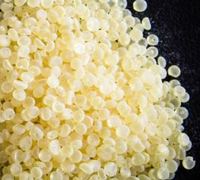C5 Hydrogenated Pe troleum Resin for Paint 8.C5 Hydrogenated Petroleum Resin
Specifications
PRETACK PA-95H is an aromatic modified C5 hydrocarbon resin with a narrow molecular weight distribution. It is odor improved grade with low odor, low wax cloud point. Its specific degree of modification provides an excellent compatibility with SIS, SBS, and EVA polymers. It has low aromatic content, especially suitable for application in SIS system Adhesives.
Key Characteristics:
·Good compatibility with SIS, SBS, EVA and other polymers
Low Wax Cloud Point
·Good thermal resistance
·Low VOC and low odor
An optimal tack / cohesion balance in SIS-based HMPSA.
Suitable for the manufacturing of high quality HM OPP tapes
··
| Typical Properties
| ||||
| Property | Test method | Unit | Typical value | |
| Color (50% resin solid in Toluene) | (ASTM D1544) | Ga # | Max5# | |
| Softening point (Ring & Ball) | (ASTM E28) | ℃ | 92-96 | |
| Melt viscosity(175℃) | (ASTM D3236) | mPa·s | Max 350 | |
| Wax Cloud Point (EVA/Resin/Wax=20/40/40) | (ETM 22-10) | ℃ | Max 105 | |
| Glass Transition Temperature (Tg) | midpoint | ℃ | 47 | |
| Acid value | (ASTM D974) | mgKOH/g | Max 0.30 | |
| Specific gravity ,@25℃ | (ASTM D71) | 20/20℃ | 0.92-0.99 |
Note:EVA=Vinyl acetate content of 27.5%(wt), Wax=Paraffin wax at 68℃ melt point.
Application
HMPSA, Solvent based PSA, Hot Melt Adhesive, Sealants.
Packaging
PA-95 is available in 25kgs paper bag or 500kgs/1000kgs in bulk bag.
GRESIN and its marketing affiliates shall not be responsible for the use of this information, or of any product, method, or apparatus mentioned, and you must make your own determination of its suitability and completeness for your own use, for the protection of the environment, and for the health and safety of employees and purchasers of your products. No warranty is made of the merchantability of fitness of any product, and nothing herein waives any of the Seller's conditions of sale.
STORAGE
Inside storage is recommended and keep at temperature not exceeding 30oC. Pelletized forms of resins may block or lump in hot weather climates or if stored near heat sources. Resins are prone to gradual oxidation, some more so than others. This could result in darkening and/or it could have an adverse effect on the solubility of the resin in organic solvents or on its compatibility with polymers.
- Country: China (Mainland)
- Business Type: Manufacturer
- Market: Africa,Americas,Emerging Markets,Europe,European Union,G20,Middle East,Oceania
- Founded Year: 2010
- Address: Guorui Cheng,Beisong Road,Changan District
- Contact: steven lee










